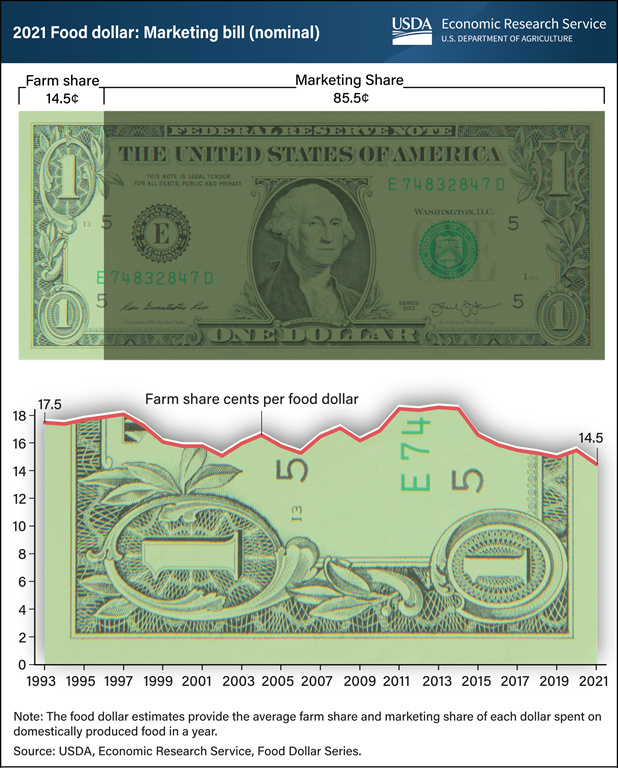Farm Share of the U.S. Food Dollar Hit a Record Low; What Does this Mean for Producers?

The farm share of the U.S. food dollar has been tracked since 1993. The 2021 data provided by the USDA on Monday shows U.S. farm share hit an all-time low.

USDA found that out of every food dollar spent, the farmer receives 14.5¢. This is down from 2020’s 15.5¢.
Seth Meyer, USDA’s chief economist, says the decrease in return doesn’t necessarily mean a producer is making less in a given year.
“If the farm share’s slice of the product pie is growing, while the pie as a whole is growing, the farm is better off in the long run,” he says.
However, Meyer says there are “bits and pieces” of the piece that eat up both food and farm shares even when overall prices go up. Some of these include:
• How much consumers are eating out
• Commodity prices
• Wholesale trade prices
• Transportation and freight costs
The Year Ahead
According to Meyer, eating out attributed most to the farm share decrease this year, but there may be next year.
Looking to 2022’s farm share predictions, Meyer thinks the trend of food away from home will slow, along with the disruptions from supply chains. However, other political and biological factors such as the war in Ukraine and avian influenza could put the coming year in jeopardy.
Do You Know Your Value-Added Opportunities?
To make the most of the farm share, Meyer suggests producers look at every angle of value-added that's at their disposal. He offers an example:
“In cattle, you have to consider if there are some value-added aspects beyond simply sending your calf to the feedlot or finished cattle to the slaughter plant,” he says. “Are there some elements that you can try and grab above that from a marketing standpoint? Or do you focus on just being a great cattle producer that makes efficient gains?”
Meyers says many opportunities in both incentives and consumer preferences often go untapped as well. He challenges producers to weigh the options.
“If consumers want that [climate-smart option] and are willing to pay, is USDA’s Climate Smart Commodities program an opportunity to make your operation better off when it comes to the share of the food dollar? You have to ask yourself these questions,” Meyer says.
More from USDA:
How USDA's $2.8 Billion Climate-Smart Investment Might Impact Your Operation
Know Someone Who Wants to Farm or Ranch, But They're Not Sure Where to Start? New USDA Funds Could Help
$670 Million Awarded by USDA to Farm, Meatpacking and Grocery Workers for their 'Essential Role' in U.S. Food Systems During Pandemic







